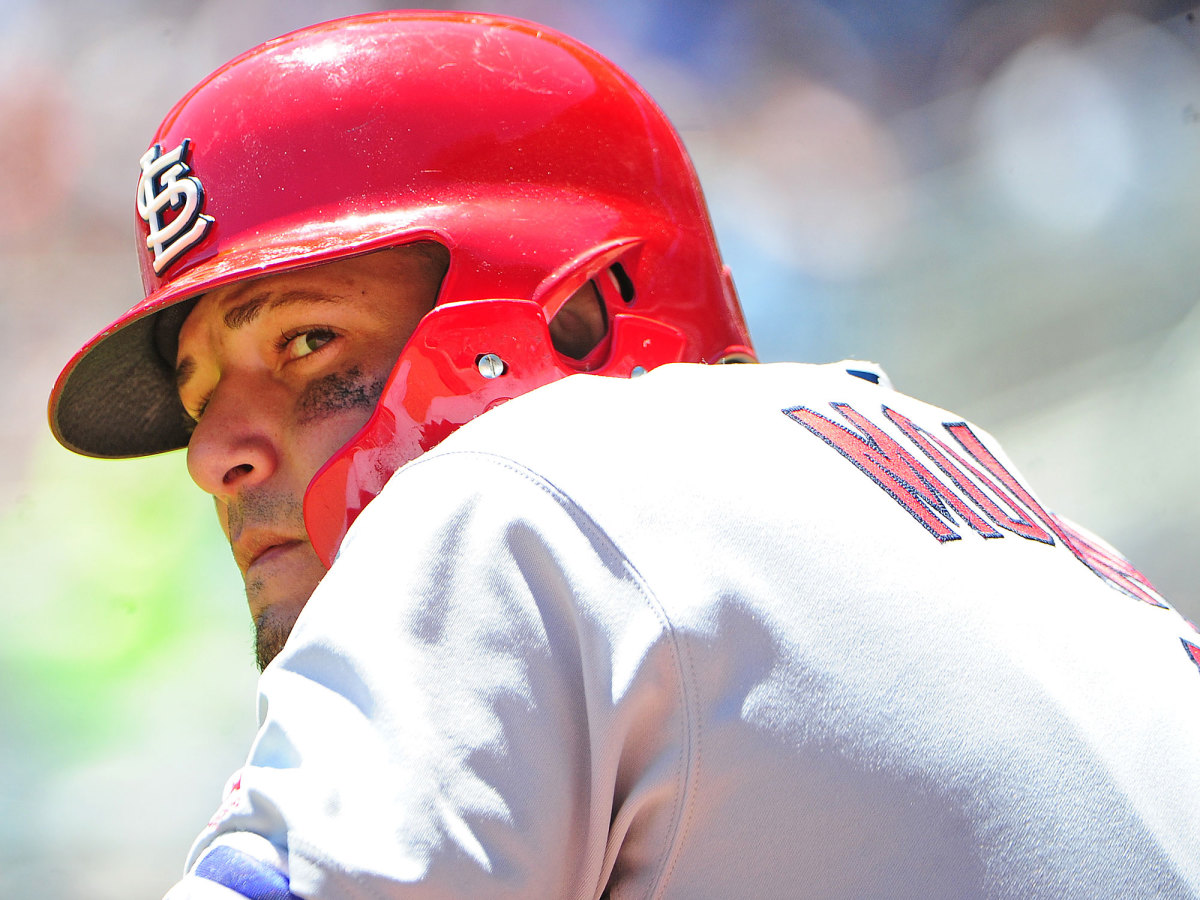The Rock Of The Redbirds: Cardinals Catcher Yadier Molina Is Part Star, Part Sage

For the past 14 years, the best catcher in baseball has been a looming presence, a shadowy specter. He lurks, his heroics often overlooked and sometimes completely unseen.
Yet Yadier Molina is still a force. His team is in a playoff race. He is hitting well. He is nearing a personal milestone. And he can still freeze opposing baserunners in place just by staring them down.
At age 35, Molina has become an institution in St. Louis. Among position players he has played the seventh-most games in franchise history. If he stays with the Cardinals through the end of the three-year, $60 million contract he signed on Opening Day he will have spent more seasons with the team than any player except legends Stan Musial (22 seasons) and Bob Gibson (17).
Still, there's no denying that 2017 marks a transition. For the first time in Molina's career, the Cardinals are grooming a successor, 23-year-old former third baseman Carson Kelly, and they promoted him to the majors seemingly for good in July. In St. Louis, there's at least a vague awareness that the Molina era will eventually come to an end. Before it does, the Cardinals' young players are going to absorb as much wisdom as they can.
After Yankees-Tigers Brawl, Has Baseball's Beanball Culture Gone Too Far?
*****
Jose Martinez is a 26-year-old utilityman who'd played 887 minor-league games before he finally reached the big leagues last September. Whether playing the outfield or first base, he almost always has one eye trained on his catcher. Yes, even when he's more than 300 feet away, Martinez squints at Molina, taking in the nearly imperceptible cues with which the catcher runs the game.
"Before every inning, I always try to listen to him about, whatever, how we are going to pitch or something," he says. "You have to be on top of everything with him. He’s going to try to sneak a throw [to first] and you have to be there. You have to get his back. It’s can’t be, oh, he caught me by surprise.”
Luke Voit, a 26-year-old first baseman who was called up to the majors in July, grew up a Cardinals fan in Wildwood, Mo., just 30 minutes away from St. Louis. When he arrived in the Busch Stadium clubhouse, plenty awestruck already, he found his locker just one down from Molina's. The catcher is one of two players—pitcher Adam Wainwright is the other—who remain from the team's 2006 World Series championship, its first in Voit's lifetime. He calls Molina "the man," and it took him only a few weeks to realize the genius of the player he'd cheered since he was an adolescent.
"In the minors, you hit, and defense kind of comes second unless you’re a really good defensive player," Voit says. "But he’s always trying to put me in the best position for me to make the best play, so I don’t have to dive or whatever. I’m right there."
Cardinals reliever Trevor Rosenthal debuted in 2012 at age 22 and was the team’s closer when they reached the 2013 World Series. Through those early high-pressure moments, Rosenthal says he rarely paused to appreciate what Molina was doing in terms of framing and pitch selection. "I don’t know if anyone else has hands like Yadi does," he explains. "I think when I first came up, I didn’t even realize what he was doing. I just felt like I was throwing strikes every pitch. It just builds your confidence, and the more I go back and look at it on video, I realized what a good job he was doing.”

Molina's game is one of millimeters and split-second glances, eye contact and imperceptible head-nods. "I try to take advantage of little details that opponents aren’t paying attention to," he says. "You have to pay attention to every detail."
Call a pitch, shift the infield, check the runner on first, fire to second, glance to the outfield. It's impossible to read everything on the field at once, but to tell Molina he can't is to challenge him to try. Mike Matheny, the Cardinals manager since 2012 and Molina's predecessor behind the plate in St. Louis, has known that about his catcher for years. "You tell him he can’t do something," Matheny says, "and just wait.”
Those words, which Matheny spoke in early July, proved almost prescient later that month. On July 28, Molina posted a since-deleted screenshot on Instagram of a Matheny quote that suggested Molina was tired and a caption refuting that assertion. The social-media spat seemed to indicate a rift between the two, one that might have divided the clubhouse. But in the month since there have been no more signs of discord, and Molina has done everything he can on the field to prove that he has as much energy as ever: He's hit .306, boosting his overall batting average by 26 points, slugged five home runs and thrown out more than half the men who have attempted to steal a base against him. In early August he helped lead St. Louis to an eight-game winning streak that briefly left the team tied for first place, though they have since fallen 4 1/2 games behind the Cubs.
Matheny has always had praise for the young player with whom he shared time in St. Louis in 2004 en route to the World Series. He lauds what Molina does behind the scenes and in the shadows, the hours he spends in the video room and in conversation with young players. Matheny says he's seen the same thing countless times: Molina spots a hitch in a player's game, likely his defense. He calls him over, says a few constructive words. "It clicks," the manager says. "It engages, and they apply it. There’s no possible way to give a guy credit when (he does) that. . . . Even times when he’s been in a rut, his body’s beat up, he’s not feeling good at the plate, you’ll still see him go out of his way to talk to somebody. That to me sets people apart."
A Game of Inches: Picking the Best Major League Player at Every Height
*****
In the next couple weeks, barring injury, Molina will catch his 1,700th career game. He's 12th on the all-time list and more than 200 in front of the Astros' Brian McCann, the next-closest active player. That does not include his 89 postseason games, also the most among active catchers, a number compiled thanks to reaching the playoffs in nine of his first 13 seasons. He has helped St. Louis win more games than any other National League team in that time, and only once have the Cardinals finished with a losing record.
Molina is MLB's longest-tenured active catcher, and he's caught more than 14,000 innings. Considering the average baseball game lasts three hours, and a catcher squats behind the plate for just under half that time, those innings equate to approximately 97 days in an exaggerated crouch—or nearly 1% of Molina's 35 years. And that’s just in games at the major-league level, never mind spring training or minor-league ball, the World Baseball Classic or pickup games back in his native Puerto Rico.
Although Molina didn’t win his first Gold Glove until 2008, his best season against potential base-stealers came in 2005, his first as a full-time starter. That year, the catcher allowed just 14 of 31 runners to swipe a base. It’s the best stolen base percentage in a single season of any catcher since Molina’s debut, and of the 10 lowest stolen base percentages in a single season since 2004, Molina owns five of them.
Molina, famously, is the younger brother of two catchers who preceded him to the majors, Bengie and Jose. Yadier was on MLB’s radar early, and there was no arguing his defensive talent. But some teams were leery that the teenager might not develop at the plate, and early on, that looked to be the case. In 51 games as a rookie he batted .267 with a .684 OPS and those numbers actually went down each of the next two seasons even as he saw more playing time.
Still, teammates saw something in his swing. In 2004, Matheny remembers discussing Molina with Albert Pujols. The veteran catcher saw his younger counterpart put the ball in play more and more, and one day, he made a prediction to Pujols. “I think this kid’s going to hit,” Matheny told the slugger.
“And nobody ever wanted to talk about it,” the manager recalls now. “All they talked about was how he threw everybody out, and he was going to pick people off every base. All that was fun to watch, but you could tell that there was a baseline there for him (at the plate).”
In the years since, Molina has grown into one of the most reliable hitters on the Cardinals roster, batting above .300 five times and pulling his career OPS to .740. This season, he has 15 home runs, the second-highest total of his career. How does Molina explain that shift in his batting—and his identity? He shrugs. “I don’t know. Probably more games, more experience.”
Matheny will speak for him: “That all came down to him deciding to take his game to another level.”
*****
Since Molina arrived in St. Louis, 28 men have appeared in a game at catcher for his team. Only 12 started more than 10 games in a Cardinals uniform, and just two have played more than two seasons in St. Louis. Fourteen never played again after their seasons backing up Molina. Only Jason LaRue, the longtime Reds backstop, and Tony Cruz, who spent five years as Molina's caddy from 2011 to '15, ever managed to gain a foothold as a consistent backup. And only one, Kelly, has ever been groomed to take over Molina’s job.
For Kelly, drafted in the second-round draft back in 2012, getting reps has been tough. Molina doesn’t cede them easily. But the young catcher has built a close relationship with his mentor over the past few seasons at spring training, where Molina has taught him the finer points of the position: how to set up, how to catch the ball. Kelly says he's never been intimidated by Molina, just awed by him.
Because of his limited playing time, Kelly has developed something of a routine with the Cardinals this season. Every day, he talks with Matheny and Molina, who occasionally partner to give him extra catching sessions on off days. In conversations, Kelly tries to break down Molina’s process, isolating the chain of decisions that leads to every play he makes. He picks Molina's brain. He even takes notes, committing the best tips to paper. On game days, he watches the first few innings from the dugout, chatting with Matheny and training his gaze on Molina almost uninterruptedly. Once it’s time for the bullpen to stir, he relocates, catching relievers’ warmups as if it’s a game.
“You learn by seeing,” Kelly says. “If everybody in the outfield and infield are watching him, I’m watching in the dugout.” But for all his study, Kelly is careful to say that he never mimics. It’s the only way he isn’t blown over by the sheer weight of it all, being the successor to the best. “I’ve got to be Carson Kelly,” he explains. “I can’t be anybody I’m not.”
The Cardinals are grooming their next catcher, but they aren’t grooming their next Yadier Molina. They can't. There won't be another.
